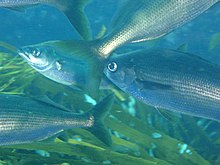Taxonomy
Latridae is classified within the superfamily Cirrhitoidea, under the suborder Percoidei of the large order Perciformes. [2] Molecular studies have also placed the superfamily within the order Centrarchiformes, although the Cirrhitoidea is confirmed as a monophyletic clade. [3] The 5th Edition of Fishes of the World does not recognise Centrarchiformes and retains the superfamily within the order Perciformes. The family has three genera according to the 5th Edition of Fishes of the World , however the authors of that book admit that further studies need to be carried out to resolve the true relationships of all the taxa within the Cirrhitoidea. [2] Latridae was first formally desecrribed as a family in 1862 by Theodore Nicholas Gill. [1]
The traditional delimitation of this family and Chaeilodactylidae is based on morphological differences, but the reliability of these differences has been questioned, and genetics do not support this treatment, either, leading some to suggest the majority of species traditionally classified as Cheilodactylidae should be placed within Latridae. [4] [5] Based on this, the only species that should remain in the family Cheilodactylidae are the relatively small Cheilodactylus fasciatus and C. pixi from southern Africa. [4] This also means the broader definition of the genus Cheilodactylus is polyphyletic. [4] [6] All other species traditionally placed within the genus "Cheilodactylus" clearly do not, according to these analyses, belong with these two in Cheilodactylus and instead appear to belong in several different genera within Latridae, but how many and their exact delimitation is not clear at present. [4]
Genera
The traditional classification places the following three genera in the family Latridae: [2] [7]
The revised classification sensu Ludt, Burridge and Chakrabarty 2019 is: [7] [8]
* means at least one member, the red moki (C. spectabilis) was traditionally classified in Chelidactylussensu lato
** means traditionally classified in Chelidactylus sensu lato
This page is based on this
Wikipedia article Text is available under the
CC BY-SA 4.0 license; additional terms may apply.
Images, videos and audio are available under their respective licenses.


